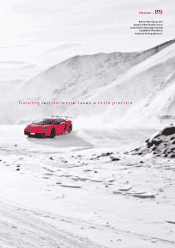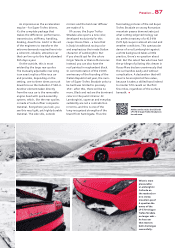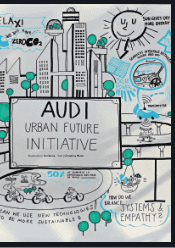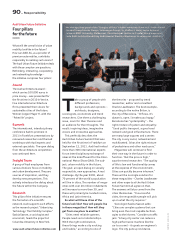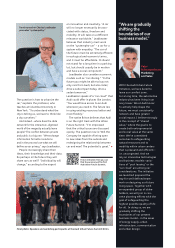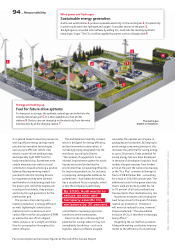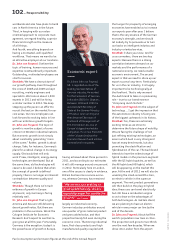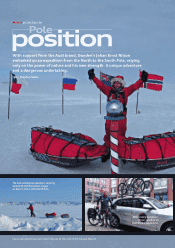Audi 2011 Annual Report Download - page 97
Download and view the complete annual report
Please find page 97 of the 2011 Audi annual report below. You can navigate through the pages in the report by either clicking on the pages listed below, or by using the keyword search tool below to find specific information within the annual report.
It is geared toward conserving resources,
with signifi cant energy savings made
possible by innovative technologies
such as more effi cient robots, new
electric motor-driven welding tongs
and especially light CFRP tools for
body manufacturing. Sometimes even
simple measures can make a crucial
contribution toward achieving a positive
balance: Reprogramming made it
possible for electric hoisting devices
to recuperate as they were lowered
and therefore to feed energy back into
the power grid. And while engines are
running on test stands, they produce
electricity through generators for the
plant power grid.
The process chain during auto-
motive production is energy-effi cient
as well: lightweight construction
materials such as aluminum and
carbon fi ber-reinforced polymer (CFRP)
as well as the use of hot-shaped
steels reduce a car’s weight and there-
fore its consumption throughout its
entire lifecycle.
The Audi balanced mobility concept,
which is designed for energy effi ciency
and environmental conservation, is
increasingly being integrated into the
workforce, according to Dreves:
“The number of suggestions in our
internal improvement system for avoid-
ing emissions and protecting the
environment has increased signifi cantly –
for improving ambient air, for instance,
or preparing rechargeable batteries for
screwdrivers.” Audi balanced mobility
has a consistent focus on people, which
is why the Company is particularly
committed to improving ergonomic
conditions at the workstations.
Clever minds can continuously fi nd
potential for savings where it may not
immediately be obvious – such as in
logistics, where a software program
calculates the optimal use of space in
packaging and containers. By helping to
avoid energy-consuming transport, this
increases the potential for saving energy
to up to 20 percent. Great potential for
saving energy has also been developed
in the area of distribution logistics: Audi
models shipped overseas from Emden
arrive at the port the carbon-neutral way
in the “Eco Plus” commercial transport
trains of DB Schenker Rail – accounting
for a total of 150,000 cars per year. The
additional costs for the green electricity
that is used are borne by AUDI AG. Up
to 70 percent of all cars produced are
transported to their destinations by rail.
Numerous measures are bringing the
Audi Group closer to the goal of climate-
neutral car production. “Emissions
will never be reduced to zero, however,”
Dreves explained. “The unavoidable
emission of CO₂ is therefore increasingly
being off set.”
Regarding the car itself as a product:
Along with making continuous improve-
ments to the effi ciency of conventional
MODEL | IHLENFELD & BERKEFELD GMBH PHOTOS | GERALD BUCHER/TANK MANAGEMENT; AUDI AG
12
75
3
6
4
By 2020, Audi wants to
reduce its site- and
Company-specifi c CO
₂
emissions by 30 percent.
94
_ Responsibility
Storage and tanking up
Fuel for future drive systems
For transport or storage, the synthetic natural gas can be fed into the
existing natural gas grid 5. It is then available as a fuel at CNG
stations 6. Electric cars can charge up on the electricity from the wind
turbines directly at the charging station 7.
Wind power and Audi e-gas
Sustainable energy generation
Audi’s own wind turbines 1 produce renewable electricity. In the electrolyzer 2, this electricity
is used to split water into hydrogen and oxygen. In another section of the plant 3,
the hydrogen is converted into methane by adding
CO₂
. Audi calls the resulting synthetic
natural gas “e-gas.” The
CO₂
could be supplied by sources such as a biogas plant 4.
Fuel consumption and emission fi gures at the end of the Annual Report
The Audi e-gas
project in miniature.



